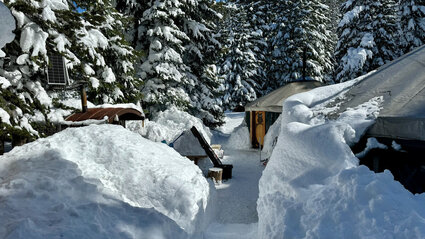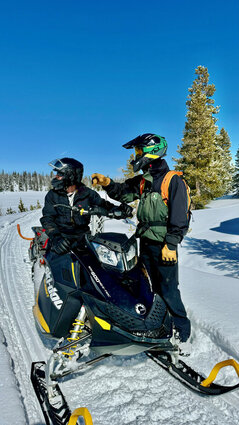Managing the forest in deep snow
Last updated 3/12/2024 at 10am
What does the Sisters Ranger District do when the ground is buried under five to 10 feet of snow, or the roads are closed? They do much of the same work they do any other time of the year. Only the means of conveyance changes.
Last week The Nugget accompanied Jim Beaupre, recreation team lead, and Skyler Ogden, recreation management specialist, in making a safety and compliance inspection around the Three Creek Lake area.
We met at the Sno Park, checked our gear, and took off, each on a District snowmobile - the lake as our first destination. The terrain is altogether different in winter, and the silence, notwithstanding engine noise, is eerily astonishing. The lake, covered with feet of snow, and the Tam McArthur Rim in the background, is a rare vista.
The District's winter goals are much the same as for the summer, keeping recreationalists safe. That starts with signs, both the direction kind and the warning kind. The first one we encounter within the first 100 yards is a large, five foot by four foot, brightly colored sign with the heading: "ARE YOU BEEPING?"
Beeping as in "do you have a locator beacon" in the event of an avalanche?
The number of backcountry skiers, snowshoers, snowmobilers, and track propelled ATV's (see related story, page 9) enjoying the forest, numbers in the thousands, with hundreds on the various delineated trails at any one time during weekend outings. Even weekdays it's easy to encounter dozens of enthusiasts.
Some actually camp there for days, either in one of two heated yurts each with six bunks and full kitchens that share a sauna, or in one of two heated wood huts that can sleep six in each. All of these units are operated by Forest Service permittee Three Sisters Backcountry run by Jonas Tarlen and his wife, Anna.
Our first stop was at the yurts where we met Jonas.
"The Tarlens are part of a large informal network of volunteers and winter recreationalists who make the winter experience possible," said Ogden.
Beaupre laid out the collaboration between the Forest Service, Sisters Trail Alliance (STA), Oregon Snowmobile Association (OSSA), and some of their local clubs, along with every day volunteers with a love for winter recreation. OSSA provides snowmobile trail grooming statewide with 100 percent volunteers.
"It just doesn't happen magically," Beaupre said, laughing. "The majority of users have no idea how many hands are involved behind the scenes to enhance their experience."
Many users at Three Creek Sno Park are unaware that the trails eventually connect to Dutchman and seven other Sno Parks on the Bend side of the massive playground. It takes seven to 10 hours of grooming, mostly done at night, to keep the myriad trails open.
Our next stop is to the wilderness boundary, off limits to snowmobiles and other motorized vehicles. "It's essential," Ogden said, "that the wilderness boundary be respected." Among many considerations, including wildlife protection, some of the wilderness is in the Bend watershed.
Both Ogden and Beaupre are also Forest Protection Officers with the authority to cite violators. Entering the wilderness can yield a $5,000 fine and six months in jail. On the Bend side Deschutes County Sheriff's deputies patrolling in pairs on snowmobiles handle most of the enforcement.
When returning we made a stop at one of the two huts that roughly follow the historic Metolius-Windigo Trail. There is no cell coverage in most of the area, and the potential for avalanches or getting trapped in a tree well is obvious. Thus these patrols are an important lifeline to backcountry seekers.

Photo by Bill Bartlett
Even when its buried under snow, Deschutes National Forest gets the attention of Sisters Ranger District personnel.
It's not just for the recreational component that the Service employs a half dozen snowmobiles, called sleds. They are kept busy by other staff. Wildlife biologists don't let winter sideline them. There are cave inspections and surveys for white-nose syndrome to be done.
White-nose syndrome is a disease caused by the fungus pseudogymnoascus destructans. The disease is estimated to have killed millions of bats in eastern North America since 2006 and can kill up to 100 percent of bats in a colony during hibernation.
Timber managers track logging contracts, and measure stand inventories and ground truthing data.
Using side-by-side, two-person utility vehicles, the fire teams are out in the winter marking prescribed burn units and accessing burn piles.
While winter is a slightly quieter time for the Forest Service, it is by no means a dormant time, or time for complacency.

















Reader Comments(0)